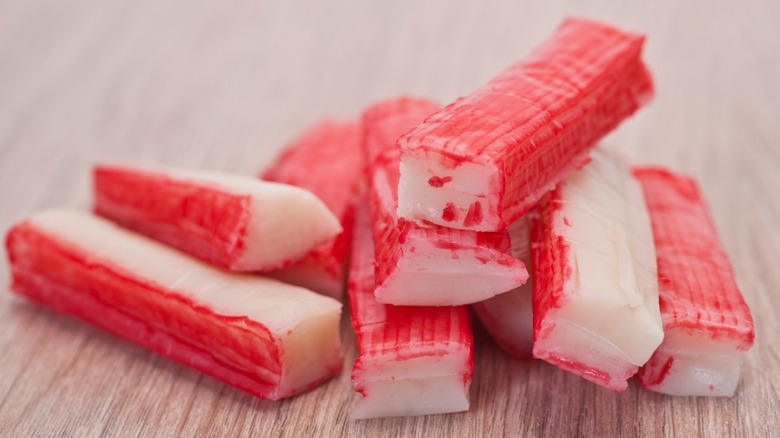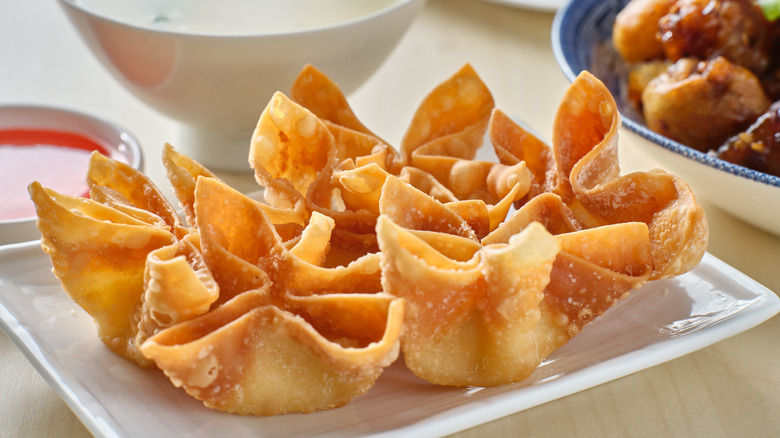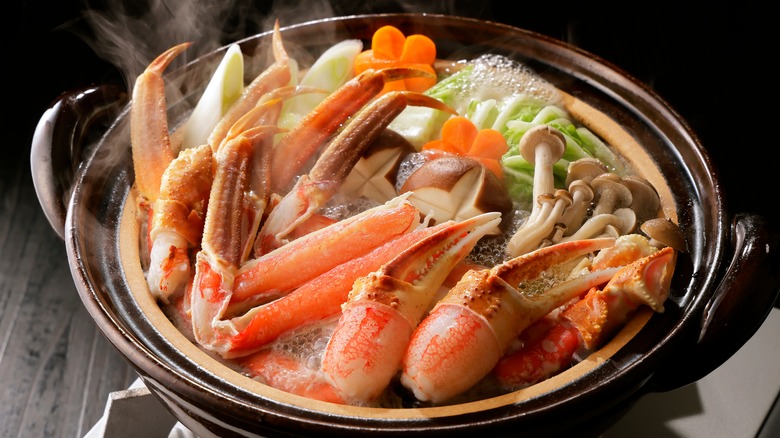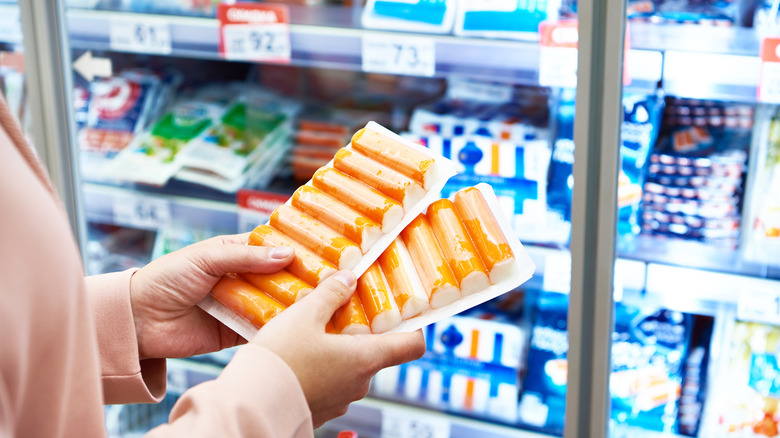Imitation Crab Belongs In The Air Fryer
Although it's not the real deal, we think imitation crab is still pretty darn good, but some people might avoid the affordable seafood replica since it's made from a fish paste rather than authentic crab. However, air-fried imitation crab is a proper delicacy, so if you're a crab purist on a budget, opt for an air-fried faux crab dish that rivals the genuine goods.
Some foodies turn their noses up to imitation crab, not because of its flavor (which is admittedly saltier than real crab), but because of its texture. Imitation crab often boasts a full, rubbery mouthfeel that's not as light as real crab, but air frying it can produce a crunchy, airy texture for a satisfying bite that distracts from its denseness. Compared to deep frying, air frying is a lower-calorie option because you don't need additional breading or frying oil to get that classic, crispy consistency. Not to mention it takes less time than traditional frying methods — tasty and efficient.
While some people enjoy uncooked imitation crab rolled up into sushi, air frying it opens a world of flavor that you can't get from eating it directly from the package. By using an air fryer, you can melt butter, oil, herbs, and spices into your imitation crab, and because air fryer circulation is designed to cook your food evenly, each bite will be bright with flavor.
Air-fried imitation crab recipe ideas
When it comes to building restaurant-worthy plates using air-fried imitation crab, creativity is encouraged. Sure, it can be as simple as olive oil-drizzled fish sticks with seasonings, but thinking outside of the box is how you can make imitation crab really stand out.
Crab cakes anyone? Mix imitation crab with breadcrumbs, egg, mayonnaise, Dijon mustard, Worcestershire sauce, celery, dill, and your favorite seasonings before forming the mixture into patties and air frying until golden and crispy on the outside. Tex-Mex fans, rejoice — Taco Tuesdays just got fishier! Dust your imitation crab with taco seasoning and air fry until slightly crispy before serving on warm flour tortillas with slaw and zesty, citrus-tinged crema.
If you don't want to deal with extra ingredients, you can always thinly slice some faux crab and air fry it with a little oil and seasonings of your choice until browned and ultra-crispy. We'd dip these fishy 'chips' in a bright tartar sauce or homemade spicy mayo.
You can also try making seafood skewers, classic crab rangoons, crab-stuffed bell peppers, or warm, crunchy crab meat for a beachy salad. Next time you want seafood for dinner, give air-fried imitation crab a chance.
Comparing imitation crab to fresh crab
Although we're fond of imitation crab, we'll be the first to admit that it doesn't taste exactly like fresh crab. Though imitation crab is pink, it's typically made from a white fish paste with added flavoring, starches, and additives to mimic the taste of fresh crab. It has a mild, slightly sweet, and somewhat briny taste that pairs well with traditional crab pairings like lemon, butter, and garlic. However, faux crab lacks the rich, buttery essence of fresh crab and needs to be properly dressed and prepared to truly imitate its seafaring counterpart.
When it comes to health benefits, fresh crab is the clear winner. It offers 24 grams of protein per one-cup serving, loads of essential vitamins and minerals, and a nice helping of heart-healthy omega-3 fatty acids, while imitation crab is a processed food that lacks these qualities.
Although it's not quite as nutritious as fresh crab, imitation crab is significantly more affordable. Due to the labor-intensive process of catching and harvesting it, crab is an expensive delicacy. Trouble with supply and demand, shipping, and species scarcity also contribute to crab's reputation as an elusive seafood ingredient. On the other hand, the most common fish used to make imitation crab is pollock, which is easier to harvest and produce in mass quantities, making the fake stuff a more affordable option for foodies who crave a crab-based experience without putting a dent in their wallet.
Finding imitation crab
Just because imitation crab isn't genuine shellfish doesn't mean you have to settle for low-quality goods. There are dozens of imitation crab varieties on the market, and knowing how to identify which type is best will make a noticeable impact on the dishes you make with it. Imitation crab is widely available at most supermarkets; if it's not near the fresh seafood section, you can find it in the frozen aisle of your local grocer. Imitation crab can also labeled as crab-flavored fish, "krab," or surimi.
When shopping for imitation crab, you're likely to find two variations — flakes or sticks. Flakes are diced chunks of fish meat that are more commonly sold in American grocers. Between the two styles, flakes have a more muted, mild flavor and a dense, rubbery texture, which is suitable for casual seafood enjoyers who don't mind these differences. Sticks, while still made with pulverized white fish, have a richer taste and a juicier quality compared to flakes. Sticks also pull apart and shred similarly to fresh crab, and they're molded to mimic the shape of real crab legs, making for a more convincing imitation.
Despite its differences, imitation crab is a solid alternative to fresh crab. And if you have an air fryer handy, trust us, you'll be enjoying restaurant-quality seafood dishes in no time.



